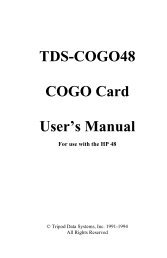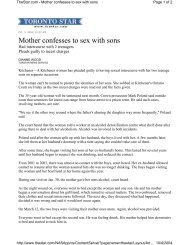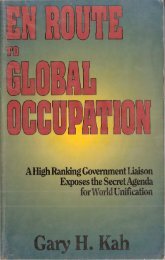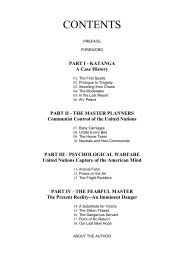- PANDEMIC - Pedos & Child Porn in the News - Equal Parenting-BC
- PANDEMIC - Pedos & Child Porn in the News - Equal Parenting-BC
- PANDEMIC - Pedos & Child Porn in the News - Equal Parenting-BC
You also want an ePaper? Increase the reach of your titles
YUMPU automatically turns print PDFs into web optimized ePapers that Google loves.
Fair Use In The Electronic Age: Serv<strong>in</strong>g The Public Interest<br />
The primary objective of copyright is not to reward <strong>the</strong> labor of authors, but "[t]o<br />
promote <strong>the</strong> Progress of Science and useful Arts." To this end, copyright assures<br />
authors <strong>the</strong> right to <strong>the</strong>ir orig<strong>in</strong>al expression, but encourages o<strong>the</strong>rs to build freely<br />
upon <strong>the</strong> ideas and <strong>in</strong>formation conveyed by a work. This result is nei<strong>the</strong>r unfair nor<br />
unfortunate. It is <strong>the</strong> means by which copyright advances <strong>the</strong> progress of science<br />
and art.<br />
-- Justice Sandra Day O'Connor (Feist Publications, Inc. v. Rural Telephone Service<br />
Co., 499 US 340, 349(1991)<br />
The genius of United States copyright law is that, <strong>in</strong> conformance with its constitutional foundation, it<br />
balances <strong>the</strong> <strong>in</strong>tellectual property <strong>in</strong>terests of authors, publishers and copyright owners with society's need<br />
for <strong>the</strong> free exchange of ideas. Taken toge<strong>the</strong>r, fair use and o<strong>the</strong>r public rights to utilize copyrighted works,<br />
as confirmed <strong>in</strong> <strong>the</strong> Copyright Act of 1976, constitute <strong>in</strong>dispensable legal doctr<strong>in</strong>es for promot<strong>in</strong>g <strong>the</strong><br />
dissem<strong>in</strong>ation of knowledge, while ensur<strong>in</strong>g authors, publishers and copyright owners appropriate protection<br />
of <strong>the</strong>ir creative works and economic <strong>in</strong>vestments.<br />
The fair use provision of <strong>the</strong> Copyright Act allows reproduction and o<strong>the</strong>r uses of copyrighted works under<br />
certa<strong>in</strong> conditions for purposes such as criticism, comment, news report<strong>in</strong>g, teach<strong>in</strong>g(<strong>in</strong>clud<strong>in</strong>g multiple<br />
copies for classroom use), scholarship or research. Additional provisions of <strong>the</strong> law allow uses specifically<br />
permitted by Congress to fur<strong>the</strong>r educational and library activities. The preservation and cont<strong>in</strong>uation of<br />
<strong>the</strong>se balanced rights <strong>in</strong> an electronic environment as well as <strong>in</strong> traditional formats are essential to <strong>the</strong> free<br />
flow of <strong>in</strong>formation and to <strong>the</strong> development of an <strong>in</strong>formation <strong>in</strong>frastructure that serves <strong>the</strong> public <strong>in</strong>terest.<br />
It follows that <strong>the</strong> benefits of <strong>the</strong> new technologies should flow to <strong>the</strong> public as well as to copyright<br />
proprietors. As more <strong>in</strong>formation becomes available only <strong>in</strong> electronic formats, <strong>the</strong> public's legitimate right<br />
to use copyrighted material must be protected. In order for copyright to truly serve its purpose of<br />
"promot<strong>in</strong>g progress," <strong>the</strong> public's right of fair use must cont<strong>in</strong>ue <strong>in</strong> <strong>the</strong> electronic era, and <strong>the</strong>se lawful uses<br />
of copyrighted works must be allowed without <strong>in</strong>dividual transaction fees.<br />
Without <strong>in</strong>fr<strong>in</strong>g<strong>in</strong>g copyright, <strong>the</strong> public has a right to expect:<br />
• to read, listen to, or view publicly marketed copyrighted material privately, on site or remotely;<br />
• to browse through publicly marketed copyrighted material;<br />
• to experiment with variations of copyrighted material for fair use purposes, while preserv<strong>in</strong>g <strong>the</strong><br />
<strong>in</strong>tegrity of <strong>the</strong> orig<strong>in</strong>al;<br />
• to make or have made for <strong>the</strong>m a first generation copy for personal use of an article or o<strong>the</strong>r small<br />
part of a publicly marketed copyrighted work or a work <strong>in</strong> a library's collection for such purpose as<br />
study, scholarship, or research; and<br />
• to make transitory copies if ephemeral or <strong>in</strong>cidental to a lawful use and if reta<strong>in</strong>ed only temporarily.<br />
Without <strong>in</strong>fr<strong>in</strong>g<strong>in</strong>g copyright, nonprofit libraries and o<strong>the</strong>r Section 108 libraries, on behalf of <strong>the</strong>ir<br />
clientele, should be able:<br />
• to use electronic technologies to preserve copyrighted materials <strong>in</strong> <strong>the</strong>ir collections;<br />
• to provide copyrighted materials as part of electronic reserve room service;<br />
• to provide copyrighted materials as part of electronic <strong>in</strong>terlibrary loan service; and<br />
• to avoid liability, after post<strong>in</strong>g appropriate copyright notices, for <strong>the</strong> unsupervised actions of <strong>the</strong>ir<br />
users. Users, libraries, and educational <strong>in</strong>stitutions have a right to expect:<br />
• that <strong>the</strong> terms of licenses will not restrict fair use or o<strong>the</strong>r lawful library or educational uses;<br />
• that U.S. government works and o<strong>the</strong>r public doma<strong>in</strong> materials will be readily available without<br />
restrictions and at a government price not exceed<strong>in</strong>g <strong>the</strong> marg<strong>in</strong>al cost of dissem<strong>in</strong>ation; and<br />
• that rights of use for nonprofit education apply <strong>in</strong> face-to-face teach<strong>in</strong>g and <strong>in</strong> transmittal or<br />
broadcast to remote locations where educational <strong>in</strong>stitutions of <strong>the</strong> future must <strong>in</strong>creas<strong>in</strong>gly reach<br />
<strong>the</strong>ir students.<br />
Carefully constructed copyright guidel<strong>in</strong>es and practices have emerged for <strong>the</strong> pr<strong>in</strong>t environment to ensure<br />
that <strong>the</strong>re is a balance between <strong>the</strong> rights of users and those of authors,publishers, and copyright owners.<br />
New understand<strong>in</strong>gs, developed by all stakeholders, will help to ensure that this balance is reta<strong>in</strong>ed <strong>in</strong> a<br />
rapidly chang<strong>in</strong>g electronic environment. This work<strong>in</strong>g statement addresses lawful uses of copyrighted works<br />
<strong>in</strong> both <strong>the</strong> pr<strong>in</strong>t and electronic environments.<br />
CONFIDENTIAL ---- Pandemic Pedo & CP Report – April 17, 2005 - page 2 of 216


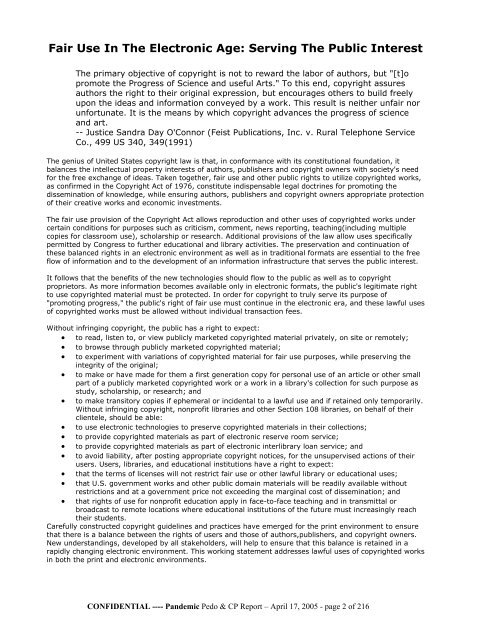
![Robert T McQuaid [rtmq@stn.net] Sent: Friday, October 29, 2004 12 ...](https://img.yumpu.com/51070071/1/190x245/robert-t-mcquaid-rtmqstnnet-sent-friday-october-29-2004-12-.jpg?quality=85)

